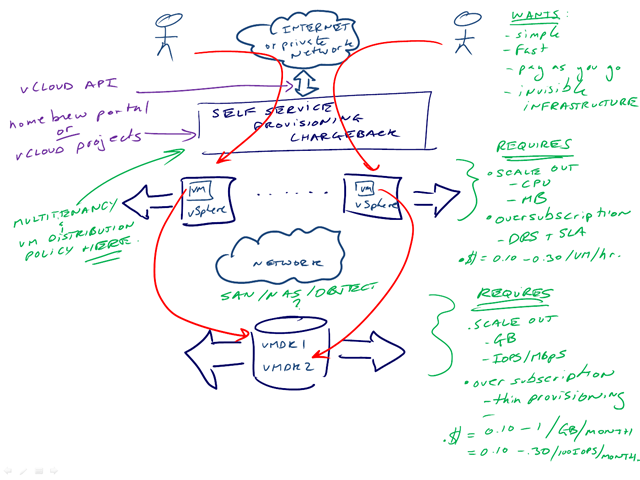Marginal notes: IaaS type cloud
This small post, as if notes in the margins, on the basic principles of the use and presentation of data center resources by the IaaS type cloud.
And so, the ideas that underlie the IaaS:
Such basic ideas and principles are present in any IaaS model. These ideas are designed and designed to be applied both to the clouds of service providers, so exclusively outside the walls of the enterprise (private cloud).
And this is generally not new! Most companies are trying to build their own models of internal IT services servicing approaching these basic principles for a long time.
The overwhelming majority of enterprises today use a resource planning model with a very significant margin for unplanned or future planned workloads. This gives a certain limited margin of flexibility and is most likely a reasonable and justifiable necessity. But, since such an excess of resources is either purchased in advance and is idle until the event of that very future arrives, or it is designed as an easy upgrade, which can take weeks for suppliers to process, agree that this is very far from rationalized use of resources.
')
Let's look at the processes of servicing the load with the resources of the enterprise offered by the cloud designed on the principles of the IaaS model.
Let's try to simulate the load. Suppose your company needs to design a hyper-efficient data center that will have self-service tools on the pay-as-you go economic model for services ranging from Exchange and Sharepoint solutions to SAP and Oracle landscapes, and it is also easy to support the development and testing tasks of your enterprise.
Of course, abstraction of each level of infrastructure is necessary here. Here is a brief diagram that shows the basic architecture of the model, what the user expects and the requirements at each level of abstraction.

Pay attention to:
Based on: http://virtualgeek.typepad.com/virtual_geek/2009/10/cloud-storage-what-the-hell-is-emc-building.html
And so, the ideas that underlie the IaaS:
- aggregation of resources into dynamically shared pools
- pay-as-you go savings model (or “on demand”)
- automation of resource management (zero-touch user interface and advanced cross-sharing tool and cloud management)
Such basic ideas and principles are present in any IaaS model. These ideas are designed and designed to be applied both to the clouds of service providers, so exclusively outside the walls of the enterprise (private cloud).
And this is generally not new! Most companies are trying to build their own models of internal IT services servicing approaching these basic principles for a long time.
The overwhelming majority of enterprises today use a resource planning model with a very significant margin for unplanned or future planned workloads. This gives a certain limited margin of flexibility and is most likely a reasonable and justifiable necessity. But, since such an excess of resources is either purchased in advance and is idle until the event of that very future arrives, or it is designed as an easy upgrade, which can take weeks for suppliers to process, agree that this is very far from rationalized use of resources.
')
Let's look at the processes of servicing the load with the resources of the enterprise offered by the cloud designed on the principles of the IaaS model.
Let's try to simulate the load. Suppose your company needs to design a hyper-efficient data center that will have self-service tools on the pay-as-you go economic model for services ranging from Exchange and Sharepoint solutions to SAP and Oracle landscapes, and it is also easy to support the development and testing tasks of your enterprise.
Of course, abstraction of each level of infrastructure is necessary here. Here is a brief diagram that shows the basic architecture of the model, what the user expects and the requirements at each level of abstraction.

Pay attention to:
- What provides multi-user mode and the deployment of virtual machines? By definition, this occurs in the virtualization layer and above, represented in the diagram by vSphere solutions. For example, on this diagram, using the vCloud API interface, the zero-touch portal of the user interface is built, allowing you to get the benefits of self-deployment, self-service, a service payment mechanism and an advanced cross-dividing tool and cloud management.
- You must have a scalable computing layer. At the same time, such a layer should have, in its basis, the support of the economic model embedded in the IaaS, in other words, to ensure the possibility of accounting for the use of resources, for example, money / WM / hour.
- Such a computational layer must have a certain degree of ability to present (allocate) resources to loads more than is physically available. For businesses, it may be of small value. For the service provider, much more. It also means that the tools that allow you to control a given quality of service are very important.
- Storage facilities with this approach also undergo significant requirements. They, as well as computing resources, should occupy their abstract layer, and, allowing to take into account resources according to the economic model, let's say money / Gb / month and money / IO / month, have the ability to scale, which would allow starting small and going to higher consumption.
Based on: http://virtualgeek.typepad.com/virtual_geek/2009/10/cloud-storage-what-the-hell-is-emc-building.html
Source: https://habr.com/ru/post/132193/
All Articles